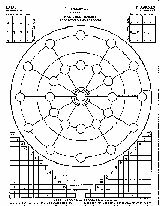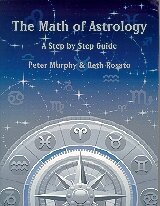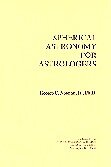
|
The Astrology Center of America, 207 Victory Lane, Bel Air, MD 21014 Tel: 410-638-7761; Toll-free (orders only): 800-475-2272 |
|||||||
|---|---|---|---|---|---|---|---|
| Home | Author Index | Title Index | Subject Index | Vedic Books | Tarot | E-Mail: | |
 |
Tables of Houses, Atlases,
|
|---|
Tables of Houses, etc., page 1
How to calculate houses using a table of houses
 |
||
 |
||

|
||
 |
||
 |
||
 |
||
Tables of Houses, etc., page 1
Okay, you wanna know my secret method. Here it is:
The Requirements:
Midnight Ephemeris
Table of Houses (any will do)
An atlas of some sort (Shanks' are excellent)
For a birth NORTH of the Equator, and,
WEST of London, eg, somewhere in North America. Later you can adapt these rules for anywhere.
First: Convert clock time to GMT. Essentially, add
5 hours for EST
6 hours for CST
7 hours for MST
8 hours for PST
Example: Birth at 10:40 am, New York, November 14, 1965: Add 5 hours to get 3:40 pm GMT.
If it's a summer birth in the US/Canada, add
4 hours for EDT
5 hours for CDT
6 hours for MDT
7 hours for PDT
Example: Birth on June 14, 1976, 1:27 pm, Los Angeles. Add 7 hours to get 8:27 pm GMT.
If the GMT time is in the afternoon, convert to 24 hour time (eg, add 12). So 3:40 pm GMT is 15:40; 8:27 pm is 20:27.
Go to your atlas. Look up the city of birth. You will find the difference between local time & GMT listed for each city. Take this number and SUBTRACT it from GMT. This will give you LOCAL MEAN TIME (LMT). Our examples:
The New York Example: Birth at 15:40 GMT. New York time difference: 4:56. Subtract 4:56 from 15:40 to get 10:44 am LMT, New York.
The Los Angeles Example: Birth at 20:27 GMT. Los Angeles time difference: 7:53. Subtract 7:53 from 20:27 to get 12:34 pm LMT, Los Angeles.
(Notice this method automatically corrects for daylight time, but you still have to know if daylight was in use.)
Go to your ephemeris. Look up the sidereal time shown for the date of birth. If the GMT time is for the next day, look up that day, not the original day of birth. ADD this sidereal time to the LMT. Our examples:
The New York example: Ephemeris sidereal time for November 14, 1965: 3:32 (the ephemeris gives seconds, I've rounded). ADD this to the New York LMT of 10:44 am to get a Sidereal Time for your chart of 14:16.
The Los Angeles example: Ephemeris sidereal time for June 14, 1976: 17:30 (rounded). ADD this to the Los Angeles LMT of 12:34 to get 30:04. As this is greater than 24, subtract 24 to get a Sidereal Time for your chart of 6:04
The Fudge Factor: Go to your Table of Houses. Find the nearest Sidereal time for your chart. Then skip to the next greater Sidereal time. This is the fudge factor, a rounding up one notch in time. Look down the table to find the latitude of birth. Those are your house cusps. They will generally be accurate within one degree without any further calculation. Our examples:
The New York Example:
The sidereal time is 14:16. In the AFA Placidus Table of Houses, I found 14:16 on page 109. I skipped to the next table for 14:20. New York is 41 degrees north (from your atlas). The results:
MIDHEAVEN: 7 degrees, 21 minutes of Scorpio
11th house: 0 degrees, 53 minutes Sagittarius
12th house: 21 degrees 13 minutes Sagittarius
ASCENDANT: 12 degrees, 25 minutes of Capricorn
2nd house: 24 degrees, 50 minutes of Aquarius
3rd house: 6 degrees, 13 minutes of Aries.
The computer gives an ascendant of 12 degrees, 11 minutes Capricorn, a difference of 14 minutes.
The computer gives a midheaven of 6 degrees, 55 minutes Scorpio, a difference of 26 minutes.
The Los Angeles example:
The Sidereal time for the chart is 6:04. I found 6:04 on page 46 of the AFA Placidus Table of Houses. I skipped to page 47, where I found a table for 6:08. It gave these results:
MIDHEAVEN: 1 degree, 50 minutes of Cancer
11th house: 3 degrees, 11 minutes of Leo
12th house: 3 degrees, 43 minutes of Virgo
ASCENDANT: 0 degrees, 50 minutes of Libra
2nd house: 28 degrees, 4 minutes of Libra
3rd house: to be 28 degrees, 33 minutes of Scorpio
The computer gives a midheaven of 1 degree, 37 minutes of Cancer, a difference of 13 minutes.
The computer gives an ascendant of 1 degree, 29 minutes of Libra, a difference of 41 minutes.
Can better hand calculation be done? Of course. The "fudge factor" is a cover for the interval between midnight GMT & birth, combined with the shift westward from London to the birth location. If you want that, here they are:
Add ten seconds for every 15 degrees west of London, add 20 seconds for every hour past midnight.
Then you will need to interpolate the chart's sidereal time to the standard sidereal times shown in the table of houses, as well as interpolate the exact latitude of birth. New York is really 40 degrees, 45 minutes north of the equator. And remember that I rounded the sidereal time shown in the ephemeris. Do all this & you should be within a few minutes of a degree of the computer.
But for those of you completely in a fog, this should help.

207 Victory Lane, Bel Air, MD 21014
Tel: 410-638-7761; Toll-free (orders only): 800-475-2272
| Home | Author Index | Title Index | Subject Index | Vedic Books | Tarot | E-Mail: |
Established 1993, The Astrology Center of America is owned & operated by David Roell.
This entire site (AstroAmerica.com) is copyright 1996, 1997, 1998, 1999, 2000 by William R. Roell.
All rights reserved.